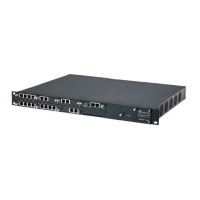User's Manual 448 Document #: LTRT-10632
Mediant 800B Gateway & E-SBC
Parameter Description
recommended that the settings of the switched IP Profile are
identical (except for the 'Send Multiple DTMF Methods' parameter)
to the initial IP Profile in order to avoid any possible call handling
errors.
This feature requires DSP resources (for detection and generation
of RFC 2833).
The parameter is applicable only to the SBC application.
SDP Ptime Answer
sbc-sdp-ptime-ans
[IpProfile_SBCSDPPtimeAns
wer]
Defines the packetization time (ptime) of the coder in RTP packets for
the SIP entity associated with the IP Profile. This is useful when
implementing transrating.
[0] Remote Answer = (Default) Use ptime according to SDP
answer.
[1] Original Offer = Use ptime according to SDP offer.
[2] Preferred Value= Use preferred ptime for negotiation, if
configured by the 'Preferred Ptime' parameter.
Preferred Ptime
sbc-preferred-ptime
[IpProfile_SBCPreferredPTi
me]
Defines the packetization time (in msec) for the SIP entity associated
with the IP Profile if the 'SBC SDP Ptime Answer' parameter (see
above) is set to Preferred Value.
The valid range is 0 to 200. The default is 0 (i.e., preferred ptime is not
used).
Use Silence Suppression
sbc-use-silence-supp
[IpProfile_SBCUseSilenceSu
pp]
Defines silence suppression support for the SIP entity associated with
the IP Profile
[0] Transparent = (Default) Forward as is.
[1] Add = Enable silence suppression for each relevant coder listed
in the SDP.
[2] Remove = Disable silence suppression for each relevant coder
listed in the SDP.
Note: The parameter requires DSP resources.
RTP Redundancy Mode
sbc-rtp-red-behav
[IpProfile_SBCRTPRedunda
ncyBehavior]
Enables interworking RTP redundancy negotiation support between
SIP entities in the SDP offer-answer exchange (according to RFC
2198). The parameter defines the device's handling of RTP
redundancy for the SIP entity associated with the IP Profile. According
to the RTP redundancy SDP offer/answer negotiation, the device uses
or discards the RTP redundancy packets. The parameter enables
asymmetric RTP redundancy, whereby the device can transmit and
receive RTP redundancy packets to and from a specific SIP entity,
while transmitting and receiving regular RTP packets (no redundancy)
for the other SIP entity involved in the voice path.
The device can identify the RTP redundancy payload type in the SDP
for indicating that the RTP packet stream includes redundant packets.
RTP redundancy is indicated in SDP using the "red" coder type, for
example:
a=rtpmap:<payload type> red/8000/1
RTP redundancy is useful when there is packet loss; the missing
information may be reconstructed at the receiver side from the
redundant packets.
[0] As Is = (Default) The device does not interfere in the RTP
redundancy negotiation and forwards the SDP offer/answer
(incoming and outgoing calls) as is without interfering in the RTP
redundancy negotiation.
[1] Enable = The device always adds RTP redundancy capabilities

